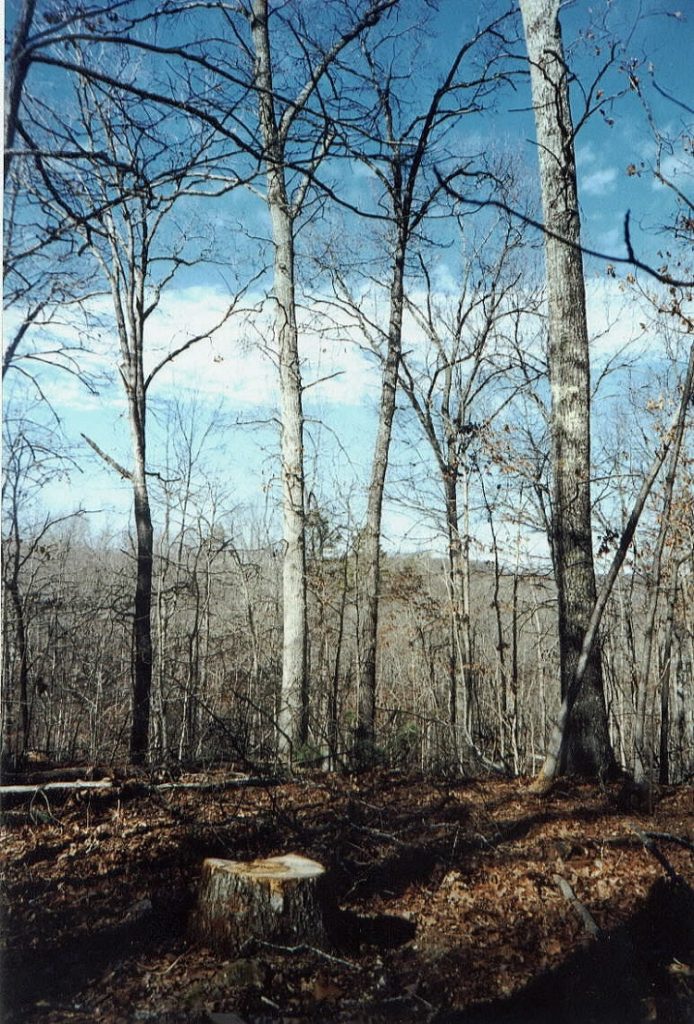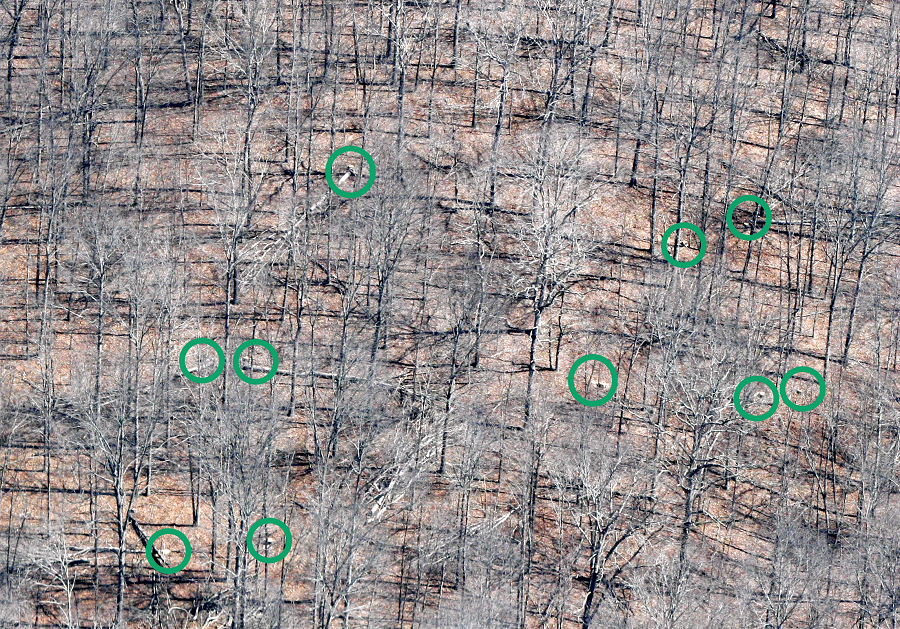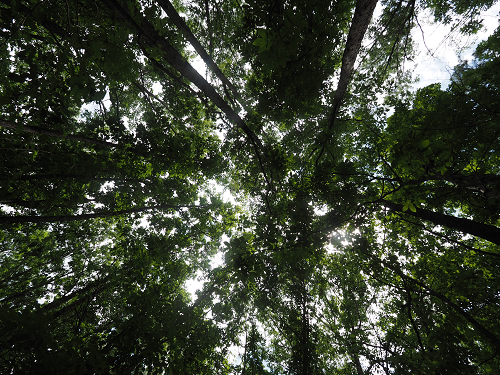L-A-D Foundation - Land Stewardship in the Missouri Ozark Highlands Since 1962
L-A-D Foundation - Land Stewardship in the Missouri Ozark Highlands Since 1962


Our Primer on Single-Tree Selection Forest Harvest
Single-tree selection harvesting is one reproduction cutting technique used for uneven-aged forest management. Using this conservative harvesting technique, managers and landowners are able to maintain a diverse and multi-aged forest (a forest with three or more age classes) while also deriving income from periodic harvests. This forest management technique provides a dynamic opportunity for forest development and succession which is essential for the continuity of the forest. Applying single-tree selection as part of an uneven-aged forest management program most closely mimics the natural process which occurs when individual trees succumb to natural mortality.
The six-minute video below, "Seventy Years of Sustainable Forest Management on Pioneer Forest," includes an explanation of Pioneer Forest's management style by Forest Manager Jason Green and Chief Forester Brandon Kuhn, who appear along with L-A-D Foundation board member, Jim Guldin, who recently retired from the US Forest Service.
To view the complete 30-minute version, as prepared for an audience of professional silviculturists, you may want to choose the video below instead. This also features our foresters and board member Jim Guldin, speaking in more depth.
When to Harvest
The application of the single-tree selection harvest method lends itself more to a qualitative description, and somewhat less to being quantified. In many ways this technique is at least as much art as it is science. From the very earliest days of Drey's ownership, the forest management philosophy was epitomized by the words of Russ Noah, former forester with Pioneer Forest: "if a tree would last for another 10 years (or until the next scheduled harvest), don't cut it." The length of time between each entry has evolved from that used beginning in the early 1950's, of about every 10 years, to a slightly longer period used today of 15-20 years for individual stands. Past cutting history and the current condition of the stand are general clues used to determine the timing of each harvest. Other factors include physical condition of the trees, growth rate, and signs of mortality. The exact timing of each harvest depends on when a particular stand achieves a closed canopy, visible signs of growth have slowed, and individual trees within both the overstory and understory express stress through evidence of such characteristics as crowding, dieback, or disease. The canopy cannot be allowed to fully close for any length of time without causing a loss of desirable seedlings, saplings, and poles, and significant components of stand structure.
Each harvest allows for removal of some of the growth as well as trees exhibiting the noted characteristics of stress. Harvests remove approximately 40% of an area's standing volume. The result is that as many or more trees of all sizes and age classes are left standing as were cut during the harvest. This system of management allows for the retention of a forest on every acre, even immediately after harvest.
Which Trees are Left and Which Trees are Harvested

Every tree on every acre of a scheduled cut is examined during the marking in order to determine whether it will be left or harvested. This is done because the trees that remain in the forest are a higher priority than the trees which are cut. The process of choosing trees to harvest is not a complicated one, but there are several important, and easy-to-apply principles which are considered while conducting a harvest in any given area. The instructions of Guldin and Baker (1998) for marking crews in southern pine forests hold just as true for Missouri Ozark forests: the simple concept is "that marking crews cut the worst trees and leave the best within each diameter or product class and among classes if necessary." Rather than high-grading the result is actually the reverse, better described as low-grading.
As a first step, marking crews identify specific trees which are to be left. Leave trees are the healthiest trees on a site, expressing the greatest potential for growth and the strongest physical characteristics, but also are species which are best suited to a particular site. For example, here in the Missouri Ozarks a healthy shortleaf pine growing on a south- or west-facing slope, or a white oak tree growing on a north- or east-facing slope would be ideal candidates for leave trees. Walking through the woods, the tree marker is constantly monitoring individual tree quality, species, and site conditions while moving through an area and across a variety of landscape conditions. The overall objective for a marker is to match the growing stock to the site, giving the leave trees room to grow by removing the poorer quality trees around them. By the same standard, even poorer quality trees, those which would otherwise be cut, may be left on site in order to meet a particular objective. (For example, post oaks are often left for wildlife as mast-producing trees; other trees are often left for den trees).
Generally, harvests on Pioneer Forest remove between 12 to 15 trees per acre. Individual trees may be marked for cutting based upon the same factors, which change depending upon the aspect, slope, physical condition of a tree, and past history of the area. There are many variables to consider when marking trees, not simply size. These include poor form, vigor, disease, and damage. The general spacing of the trees as evidenced on the ground but often more importantly, observed in the forest canopy is important as well. A marked tree which is harvested leaves a hole or opening in the canopy. This opening in the canopy provides an opportunity within the forest for the best trees which remain to continue their growth. Leave trees benefit from the small gap which adds light and reduces competition for space, water, and soil nutrients. During the 15-20 year period between harvests, these understory trees occupying the gap, grow into the canopy, and the seedlings on the forest floor develop into saplings. This progressive development of small trees into large ones is critical to the method's success.
In many ways, the nature of the single-tree selection harvest technique is an accelerated version of the natural changes that might occur within the forest over much longer periods of time. Time, combined with risk factors such as mortality, make all the difference in understanding how this method of forest management works.

Individual tree stumps on Pioneer Forest circled. PHOTO BY: Dale Dufer
The Dynamic Influence of Light
Harvest activities allow direct light to penetrate the forest canopy where a tree has been removed. Harvesting one or a few trees creates canopy gaps that vary in size but occur in an irregular pattern across the landscape. Light penetration continues for some time into the future until each canopy gap is eventually filled in. Diffuse light is also continuously present within the forest by being transmitted through smaller gaps in the canopy (such as dead limbs or spaces between adjacent trees), as well as by being reflected off of the leaves, trunks, and limbs of the trees within the forest.

As more trees grow per acre, the canopy closes and less light reaches the forest floor. PHOTO BY: ANW
Our experience with successful uneven-aged management on Pioneer Forest has shown that removing a larger number of trees, for example small groups of trees, from any given area is not necessary to promote the penetration of sunlight to the forest floor. Replacement of individual trees within the canopy, primarily by oak and pine, has always been a result of the canopy gap dynamics occurring as a result of each harvest.
Forests under single-tree selection cutting benefit from a continual provision of light as a built-in component of this method of forest management. Both direct and diffuse light reach the forest floor as trees are removed during each harvest entry. These sources of light continually shift in space and time. While the actual source for light within the forest may vary (because of the heterogeneous nature of providing light energy through single-tree selection management), the provision of light is automatic. Thus, the light environment promoted by removing individual trees appears to continuously influence the development and maintenance of the forest structure under this method of management.
Other research on various oak species has suggested that shade tolerance may not be as fixed as often suggested. It has been has shown that oaks adjust to variation in light conditions by shifting the timing of their spring budbreak, based on their exposure to light during the previous year. Seedlings and saplings beneath a forest canopy begin growing earlier in the spring than open-grown oaks when light and moisture conditions are the most favorable. This response in several oaks; namely, white, black, scarlet, post (Q. stellata), chestnut (Q. prinus), and northern red oaks--has also been found in other species including hickories and white ash (F. americana).
Understanding how the highly irregular but constant provision of direct light as a result of single-tree selection management works may be the key for successfully managing a variety of forests.
Reducing Disturbance Effects and Harvest Damage to Residual Trees Within the Forest
Under uneven-aged forest management, abiotic variables, such as percent canopy coverage, temperature, and humidity, show measurably fewer changes among the trees than in forests under even-aged management (San Diego 2001). This reduced environmental variability provides for increasing stability to forest structure through time (when compared to the change created from even-aged management methods), and represents a unique opportunity to restore and then maintain a forest condition in the landscape. However, protecting leave trees during successive harvests and until maturity requires deliberate and careful application of specific cutting and removal techniques when compared to other methods of forest management. The following are several steps which may be used to minimize damage:
- Require that the felling and skidding operations work together, beginning at the bottom of a hill and proceeding to the top.
- Mark each tree to be removed on both its uphill and downhill sides. Mark the uphill side at chest height and mark the backside at the base of the tree. Marking the backside of the tree allows the skidder driver to use marked trees as pivot points when a load needs to be turned, thereby reducing or eliminating damage to higher quality leave trees remaining in the forest.
- Have sawyers trained in using directional felling. This is the ideal cutting technique for single-tree selection harvests, significantly reducing damage to the residual stand, as well as improving both production and safety. Directional felling reduces damage within the forest, as well as the potential danger from hanging up, as well as fiber pull, and splitting. An especially good overview of these ideas and the technique are found in Maine Employers' Mutual Insurance Company's Production Felling Through Safety (1994).
- Re-use ridge roads and skid trails for removing logs and for equipment access. Require single lane for skid trails and keep improvements to a minimum.
- Avoid late winter and early springtime operations while the sap is moving or when roads and skid trails are particularly subject to rutting and erosion. This simple technique will minimize rutting of roads and excessive bark damage on leave trees.
Additional Tips for Private Landowners
A private landowner will need some assistance in managing a forest properly. The next video clip describes the first of five steps in good forest management:
- Identify consulting forester
- Inventory of assets
- Management plan
- Mark trees
- Logging
Also below we have provided a short clip on the final step, finding loggers. In Missouri, the best resource is the Missouri Consulting Foresters Association. See their roster here.
Click above to view Pioneer Forest brochure or right click and "save as" to save
© 2013-2023 L-A-D FOUNDATION ♦ 725 KINGSLAND AVE., SUITE 100, ST. LOUIS, MO 63130 ♦ 314-621-0230 ♦ EMAIL: INFO@LADFOUNDATION.ORG
PIONEER FOREST ♦ PO BOX 497, SALEM, MO 65560 ♦ 573-729-4641
♦ SEE PRIVACY POLICY
This site maintained by Craig Technology Consulting • 201 E. 4th St. • Salem, Missouri 65560 • PH 573.453.2322